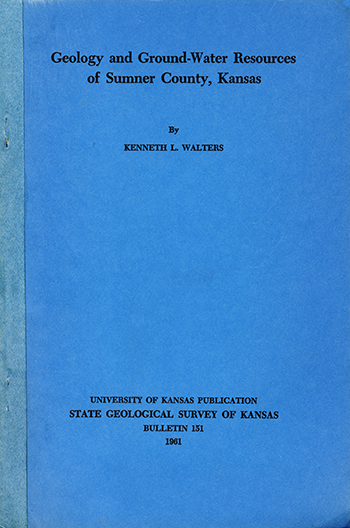Geology and Ground-water Resources of Sumner County, Kansas
by Kenneth L. Walters, U.S. Geological Survey

Originally published in 1961 as Kansas Geological Survey Bulletin 151. This is, in general, the original text as published in 1961. The information has not been updated.
You may also wish to visit our web site on the Sumner County geologic map.
Abstract
This report describes the geography, geology, and ground-water resources of Sumner County in south-central Kansas. The hydrologic and geologic data upon which this report is based were obtained in the field during the summers of 1955 and 1956. Records of 300 wells and 2 springs, chemical analyses of 219 water samples from wells and test holes and of 15 from streams, and logs of 362 wells and test holes are included in tables.
Sumner County has an area of 1,183 square miles and lies in the Wellington Lowland and Arkansas River Lowlands of the Central Lowland physiographic province. It is drained by Arkansas River, Ninnescah River, and Chikaskia River and their tributaries. The land surface in general is a southeastward-sloping, gently rolling plain. The average annual precipitation at Wellington is about 31 inches. Wheat fanning is the principal industry of the county, and oil is the chief natural resource.
The Wellington Formation, of Permian age, crops out in the eastern two-thirds of the county except where it is covered by Pleistocene deposits. The Ninnescah Shale (Permian) overlies the Wellington Formation and crops out in parts of the western third of the county. The Permian rocks yield small quantities of hard water to wells. Pleistocene sand and gravel deposits of Nebraskan age are present in the northwestern corner of the county and yield moderate quantities of good water to wells. Discontinuous deposits of Kansan or Illinoisan age, locally mantled by colluvium, forms terraces in southern and eastern Sumner County, and may yield moderate quantities of water. Wisconsinan terrace deposits and Recent alluvium along the major streams yield large quantities of water. Colluvium and dune sand are unimportant as sources of water but may facilitate recharge.
Maps of Sumner County included in this report show the outcrop areas of the formations, geologic cross sections, the shape and slope of the water table, the locations of wells and test holes for which records are given, and the distribution of chloride in water samples.
The ground-water reservoir is recharged principally from rain and snow that fall within the county, by percolation from streams and other surface bodies of water, and by underflow from adjacent areas. Water is discharged from the ground-water reservoir by seepage into streams, by transpiration and evaporation, by movement into adjacent areas, and by wells. Water is pumped from wells for domestic, stock, municipal, industrial, and irrigation use. Irrigation from wells is most extensive in the valley of Arkansas River, in which area further development is most probable.
Chemical analyses of samples of water from Sumner County indicate that the quality varies greatly from place to place. Sulfate is common in water from the Wellington Formation and Ninnescah Shale. Water from Pleistocene deposits is generally suitable for most uses except in local areas where it contains excessive chloride.
Kansas Geological Survey, Geology
Placed on web January 2003; originally published August 1961.
Comments to webadmin@kgs.ku.edu
The URL for this page is http://www.kgs.ku.edu/General/Geology/Sumner/index.html